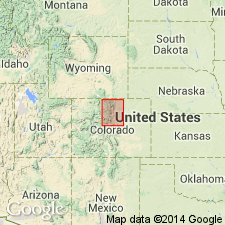
- Usage in publication:
-
- Troublesome formation*
- Modifications:
-
- Original reference
- Dominant lithology:
-
- Sand
- Clay
- AAPG geologic province:
-
- North Park basin
Summary:
Pg. 41. Troublesome formation. Name applied by A.H. Richards [1941, Univ. Michigan PhD dissert.] to several hundred feet of light-gray to light-tan tuffaceous sands and clays in valley of Troublesome Creek. Equivalent strata in South Park called Antero formation; east of South Park called Florrisant lake beds; in Denver basin called Castle Rock conglomerate. Contains both Oligocene and late Miocene or early Pliocene fossils. Age is considered Oligocene.
Named from occurrence in valley of Troublesome Creek, near Kremmling in Middle Park, Grand Co., northwestern CO. Covers about 160 sq mi.
Source: US geologic names lexicon (USGS Bull. 1200, p. 3960-3961); supplemental information from GNU records (USGS DDS-6; Denver GNULEX).
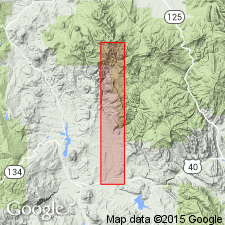
- Usage in publication:
-
- Troublesome formation
- Modifications:
-
- Areal extent
- AAPG geologic province:
-
- North Park basin
Summary:
Pg. 8-9. Troublesome formation. Youngest Tertiary sediments in Middle Park Basin; lies unconformably on all older formations. Maximum thickness 960 feet, measured along Troublesome Creek north of U.S. Highway 40. Upper 800 feet consists of volcanic ash in beds as much as 30 feet thick, interbedded with clays and fluvial sands. Deposited during Oligocene time and reworked during Miocene and Pliocene.
Source: US geologic names lexicon (USGS Bull. 1200, p. 3960-3961).
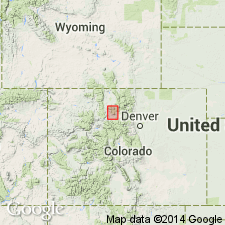
- Usage in publication:
-
- Troublesome Formation*
- Modifications:
-
- Areal extent
- AAPG geologic province:
-
- North Park basin
Summary:
Troublesome Formation. Locally in Middle Park area, Hot Sulphur Springs quadrangle, Grand County, northwestern Colorado, separates Rabbit Ears Volcanics (new; Oligocene and Miocene?) from Grouse Mountain Basalt (new; Pliocene?). Age is Miocene.
Source: Publication.
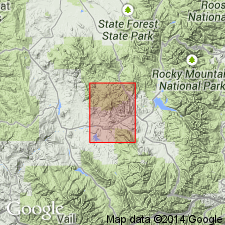
- Usage in publication:
-
- Troublesome Formation*
- Modifications:
-
- Reference
- Dominant lithology:
-
- Siltstone
- Limestone
- Ash
- AAPG geologic province:
-
- North Park basin
Summary:
Pg. 6, 40-53, geol. map. Troublesome Formation. Separated into (1) siltstone facies, moderate-grayish-orange to gray, light-brown, and light-green tuffaceous clayey siltstone, locally calcareous; and (2) conglomeratic facies, varicolored tuffaceous swelling claystone and sandstone with lenses and stringers of conglomerate. Thickness 0 to 400 feet in quadrangle; 969 feet at reference section. Rests with marked unconformity on older rocks. Fossils. Age is late early and late Miocene.
Reference section: in lower Barger Gulch, in SW/4 sec. 24, T. 1 N., R. 80 W., and SW/4 sec. 19, T. 1 N., R. 79 W., Kremmling 15-min quadrangle [Junction Butte 7.5-min quadrangle], Grand Co., northwestern CO.
Source: Publication.
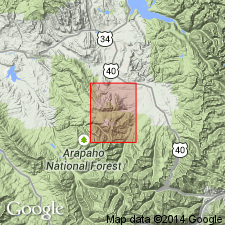
- Usage in publication:
-
- Troublesome Formation*
- Modifications:
-
- Mapped
- AAPG geologic province:
-
- North Park basin
Summary:
Troublesome Formation. Light-gray and light-brown to light-grayish-orange tuffaceous siltstone rich in swelling clays; lenses of light-tan to brown arkosic sandstone and conglomerate near basin margins; local beds or lenses of white water-laid tuff. Thickness probably greater than 800 feet (245 m). Bounded by unconformities. Age is Miocene. Mapped mostly in northeastern part of quadrangle.
Source: Publication.
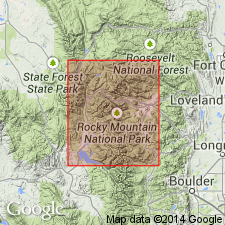
- Usage in publication:
-
- Troublesome Formation*
- Modifications:
-
- Age modified
- AAPG geologic province:
-
- North Park basin
Summary:
Troublesome Formation. Gray and orange-gray, tuffaceous mudstone and sandstone, volcanic ash beds, and minor clayey limestone and conglomerate. Contains several interlayered basaltic lava flows. Rests unconformably on rocks that are Late Cretaceous to Early Proterozoic in age. Age is late Oligocene and early Miocene. K-Ar and fission-track dates on volcanic ash and interlayered basalt indicate that lower part of formation was deposited in this area between 23 and 29 Ma (!zett, 1975, GSA Mem. 144, p. 179-210; R.L. Drake, written commun., 1982) [Oligocene-Miocene boundary 24 Ma].
Source: Publication.
For more information, please contact Nancy Stamm, Geologic Names Committee Secretary.
Asterisk (*) indicates published by U.S. Geological Survey authors.
"No current usage" (†) implies that a name has been abandoned or has fallen into disuse. Former usage and, if known, replacement name given in parentheses ( ).
Slash (/) indicates name conflicts with nomenclatural guidelines (CSN, 1933; ACSN, 1961, 1970; NACSN, 1983, 2005, 2021). May be explained within brackets ([ ]).

